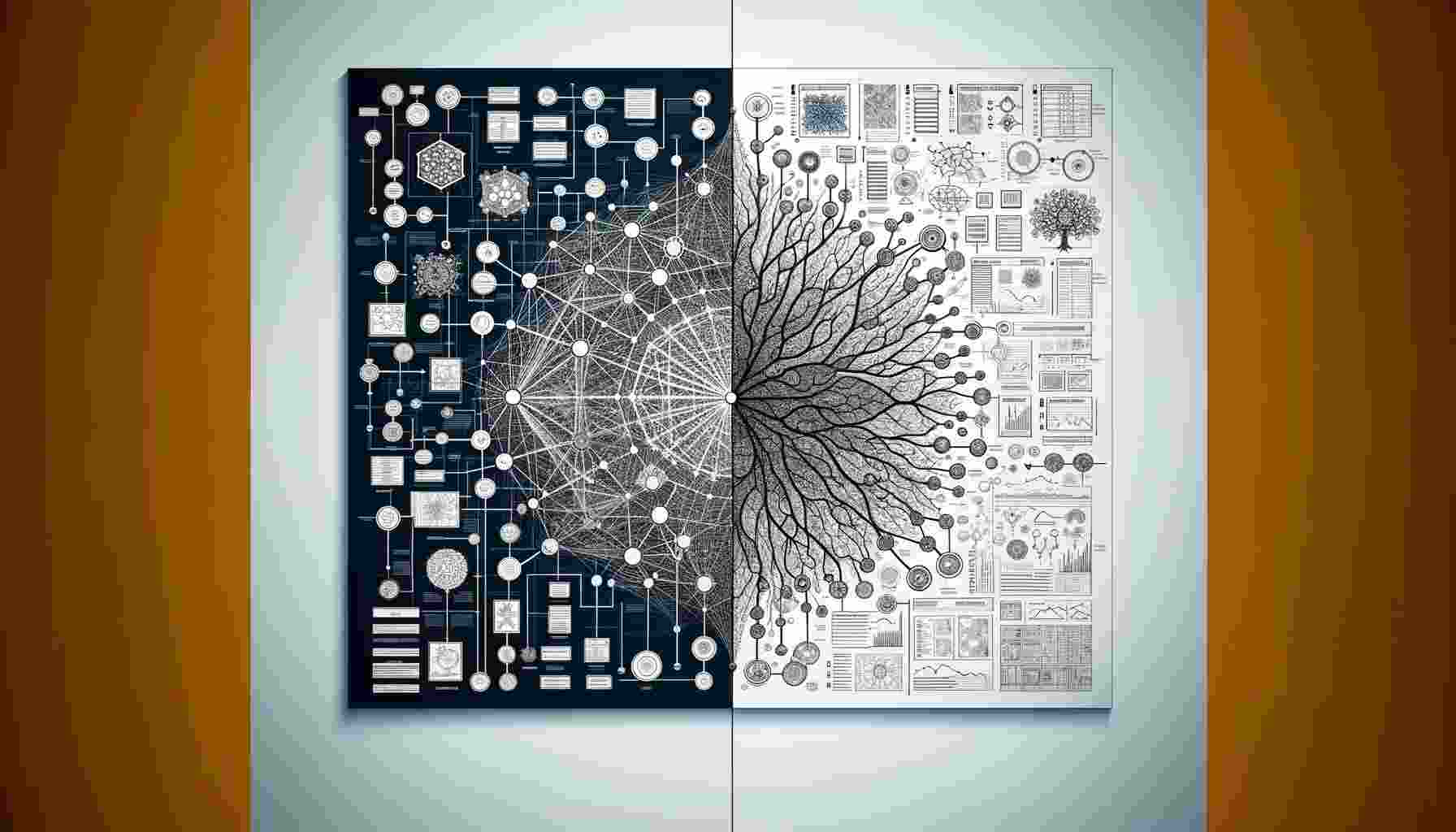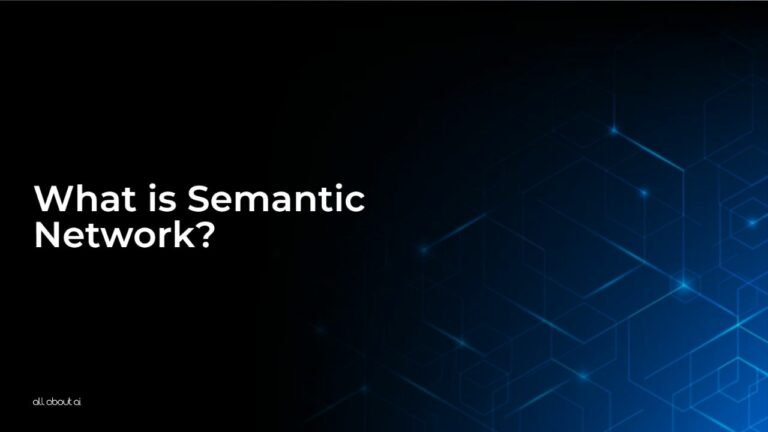What is a semantic network? It is a form of knowledge representation in artificial intelligence (AI) that graphically represents relationships between concepts. It’s akin to a map of ideas, where each node represents a concept or entity, and the links, often labeled, depict the relationships between these concepts.
Looking to learn more about this concept in AI? Keep reading this article written by the AI specialists at All About AI.
What is a Semantic Network? : The Brainy Web of AI!
Imagine a semantic network as a big spider web of ideas. It’s a special way to show how different things are related to each other in the world of artificial intelligence (AI). Think of it like a treasure map, where each spot on the map is an idea or thing, and the lines between them are like paths that show how these ideas are connected. Some of these paths even have signs that tell us how they are connected. It’s like drawing a map of all the things you know and showing how they are linked together!
Why Are Semantic Networks Important in AI?
Semantic networks play a crucial role in artificial intelligence by enabling machines to understand and process complex relationships between concepts, much like how humans associate ideas and meanings.
Here’s what they are important in AI.

Enhancing Natural Language Processing
Semantic networks play a pivotal role in enhancing natural language processing. By enabling AI systems to decipher context and meanings of words, they contribute significantly to advancements in AI’s ability to process human language.
Key to Knowledge Representation
Semantic networks offer an advanced form of knowledge representation in AI. They structure complex relationships between concepts, facilitating efficient knowledge retrieval and management, essential for intelligent decision-making in AI systems.
Boosting Machine Learning Capabilities
Semantic networks are instrumental in enriching machine learning processes. By providing a framework for AI systems to reason and make inferences, they empower machine learning algorithms with deeper understanding and decision-making skills.
Facilitating Cognitive Modeling in Knowledge Management
These networks are invaluable in knowledge management, reflecting human cognitive processes. They aid in modeling human memory and learning, offering insights that drive the development of more intuitive AI systems.
Improving AI Systems’ User Interaction
Semantic networks significantly improve user interaction with AI systems. By providing a more nuanced understanding of user queries and contexts, they enhance the overall user experience in AI applications.
How Do Semantic Networks Operate?
Here’s a breakdown of how semantic networks operate.
Establishing Nodes for Data Visualization
Semantic networks begin by establishing nodes, each representing a unique concept, akin to data visualization techniques where complex information is visually organized in AI systems.
Linking Nodes in Graphical Models
The network’s structure is defined by linking nodes, a critical aspect of graphical models in AI. These links illustrate the intricate web of relationships between different concepts.
Integrating with AI Algorithms for Machine Learning
Once the structure is set, semantic networks are integrated with various AI algorithms. This integration is crucial for machine learning, as it allows AI systems to process and interpret the network, leading to informed decisions.
Evolving Networks in AI Systems
Semantic networks continuously evolve, adapting to new information and changing scenarios. This flexibility ensures that AI systems remain up-to-date and relevant in dynamic environments.
What Are the Types of Semantic Networks?
There are several types of semantic networks, including definitional networks (which define concepts), assertional networks (which assert facts or knowledge), and hybrid networks (which combine features of both definitional and assertional networks).
- Definitional Networks: These networks focus on defining concepts, crucial for establishing clear and concise knowledge representation in AI.
- Assertional Networks: Essential for stating specific facts or knowledge, assertional networks play a key role in the practical application of AI.
- Hybrid Networks: Combining features of both definitional and assertional types, hybrid networks offer a comprehensive approach to knowledge representation in AI.
- Temporal Networks: These networks incorporate time-based relationships, important for AI applications that require dynamic understanding.
- Causal Networks: Central to decision-making in AI, causal networks map out cause-and-effect relationships.
Where Are Semantic Networks Applied?
Semantic networks find applications in numerous AI fields. These include natural language processing, knowledge representation, information retrieval, and understanding human cognition in psychology.
Natural Language Processing
Semantic networks significantly enhance natural language processing capabilities in AI, enabling systems to better understand and interact using human language.
Knowledge Management Systems
In knowledge management, semantic networks streamline the organization and retrieval of information, making AI systems more efficient and user-friendly.
Decision Support in AI Systems
They play a crucial role in decision support systems, providing a clear and logical structure for analyzing various factors and outcomes.
Enhancing Machine Learning in Educational Technologies
In educational technologies, semantic networks aid in creating personalized learning experiences, leveraging machine learning to adapt to individual learning patterns.
Cognitive Research in Knowledge Representation
These networks are also employed in cognitive research, helping to model and understand human thought processes, thereby enriching the field of knowledge representation in AI.
Comparing Semantic Networks with Other Knowledge Representation Techniques
Semantic networks are often compared with other knowledge representation techniques like frames, scripts, or ontologies.
Here’s how they differ:

Versus Frames and Scripts
Semantic networks offer a more flexible representation of knowledge compared to the structured nature of frames and scripts.
Versus Ontologies
Ontologies are more formalized than semantic networks, often used for defining standardized vocabularies in AI.
What Challenges Do Semantic Networks Face?
Here, we discuss the challenges faced by semantic networks.
Complexity and Scalability
As semantic networks grow in size and complexity, managing and processing the vast number of nodes and relationships becomes increasingly challenging. This scalability issue can lead to difficulties in maintaining efficiency and accuracy, especially in large-scale AI applications.
Ambiguity and Misinterpretation
Semantic networks, by their nature, may contain ambiguous relationships or concepts that can lead to misinterpretation. Ensuring clear and unambiguous representation of relationships is a constant challenge, as misunderstandings can significantly affect the performance and reliability of AI systems relying on these networks.
Integration with Other AI Systems
Integrating semantic networks with other AI systems and technologies, such as machine learning algorithms or decision support systems, can be complex. Ensuring seamless integration while maintaining the integrity and utility of the semantic network is a significant challenge.
Dynamic Updating and Evolution
Keeping semantic networks up-to-date with the latest information and evolving them to adapt to new knowledge or changing scenarios is challenging. This requires continuous monitoring and updating mechanisms, which can be resource-intensive and complicated to manage.
Data Quality and Source Reliability
The effectiveness of a semantic network heavily depends on the quality and reliability of the data it represents. Challenges arise in ensuring that the data feeding into these networks is accurate, relevant, and from trustworthy sources, especially in an era where information is vast and varied.
How Are Semantic Networks Evolving?
Semantic networks are evolving through integration with machine learning and other AI techniques. This evolution enables more dynamic and adaptive knowledge representation, better handling of ambiguous or incomplete information, and enhanced ability to model complex systems.

Advanced Machine Learning Integration
Semantic networks are integrating with machine learning for dynamic learning and adaptive knowledge representation, enhancing accuracy and relevance.
Big Data Analytics Incorporation
These networks are evolving to handle big data, enabling processing of vast datasets for complex AI applications in various fields.
Enhanced Natural Language Processing
Semantic networks are improving in natural language processing, becoming more adept at interpreting and responding to natural language queries in AI applications.
Real-time Dynamic Updating
Real-time data processing technologies enable semantic networks to update instantaneously, essential for applications needing current information like financial analysis and social media monitoring.
Want to Read More? Explore These AI Glossaries!
Engage with the world of artificial intelligence through our thoughtfully compiled glossaries. Whether you’re a beginner or an advanced student, there’s always something fresh to explore!
- What Is Futures Studies?: Futures studies, also known as futurology, is an interdisciplinary field that seeks to explore, anticipate, and systematically analyze potential future events and trends.
- What is a Fuzzy Control System?: A fuzzy control system is a type of intelligent control system that uses fuzzy logic, a form of many-valued logic, to handle imprecise or complex information.
- What is Fuzzy Logic?: Fuzzy logic is a form of many-valued logic that deals with approximate, rather than fixed and exact reasoning. Binary sets are 0 or 1 or true or false, which is what we’re used to.
- What is a Fuzzy Rule?: A fuzzy rule in artificial intelligence (AI) is a form of knowledge representation used in fuzzy logic systems.
- What is a Fuzzy Set?: In the realm of artificial intelligence, a fuzzy set is a mathematical model that allows for degrees of membership rather than binary membership as in classical sets.
FAQs
What is a semantic network in AI with example?
What is the best example of a semantic network?
What are the advantages of semantic networks in AI?
What are the three main components of the semantic network?
Conclusion
Semantic networks are a powerful tool in AI, offering a unique way to represent and process complex relationships between concepts. They are pivotal in enabling machines to understand context and relationships akin to human cognition, making them invaluable in the ongoing journey of AI advancement.
This article comprehensively answered the question, “what is a semantic network.” If this article has piqued your interest, why not continue exploring the world of AI? To do so, check out the articles we have in our AI knowledge book.





